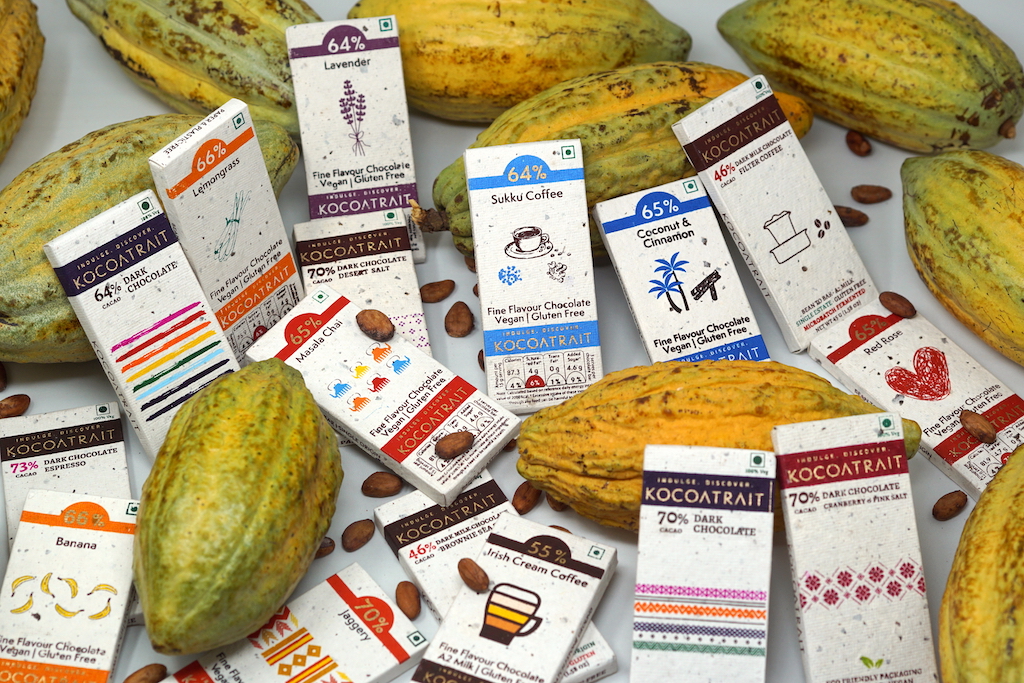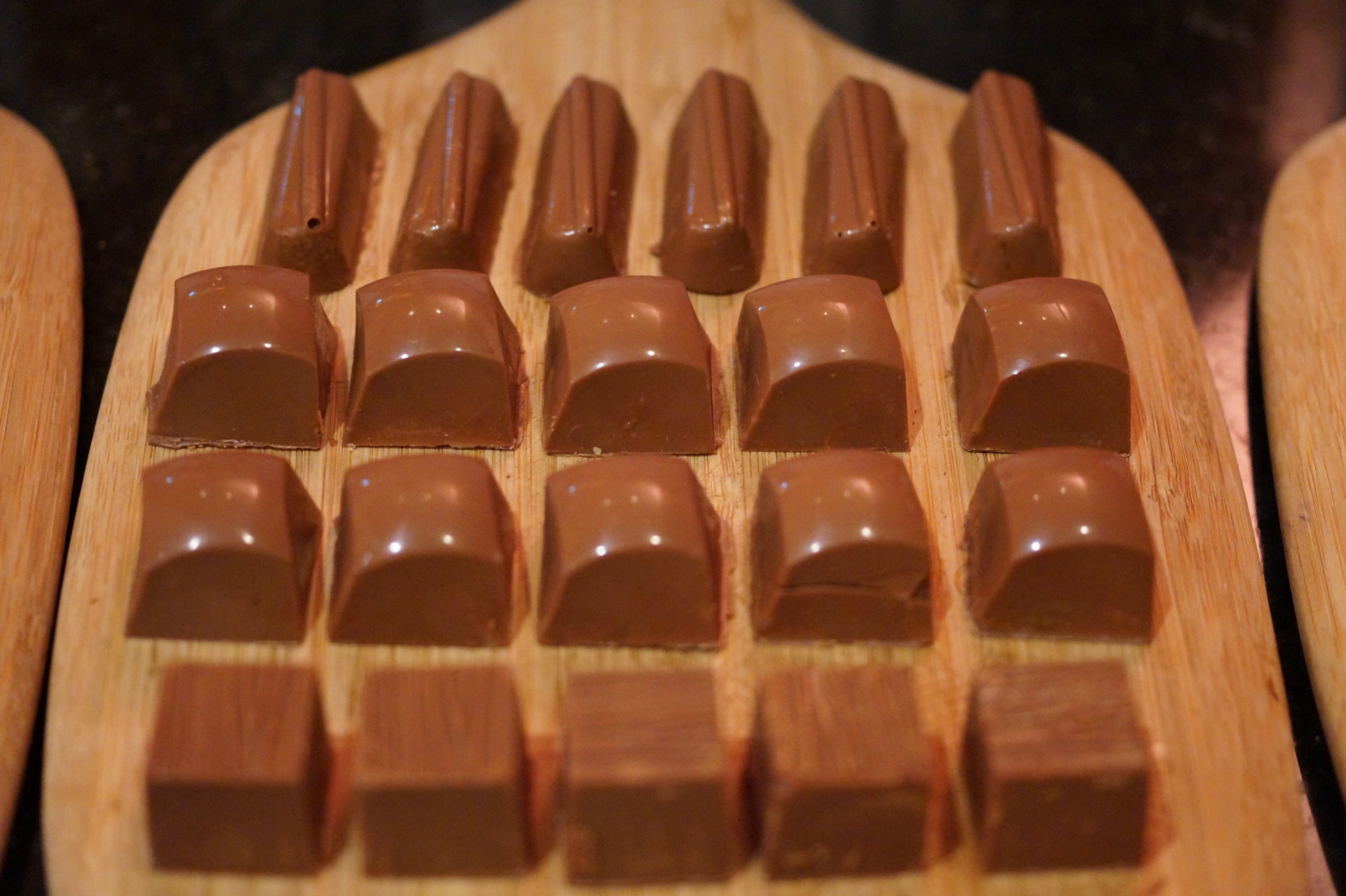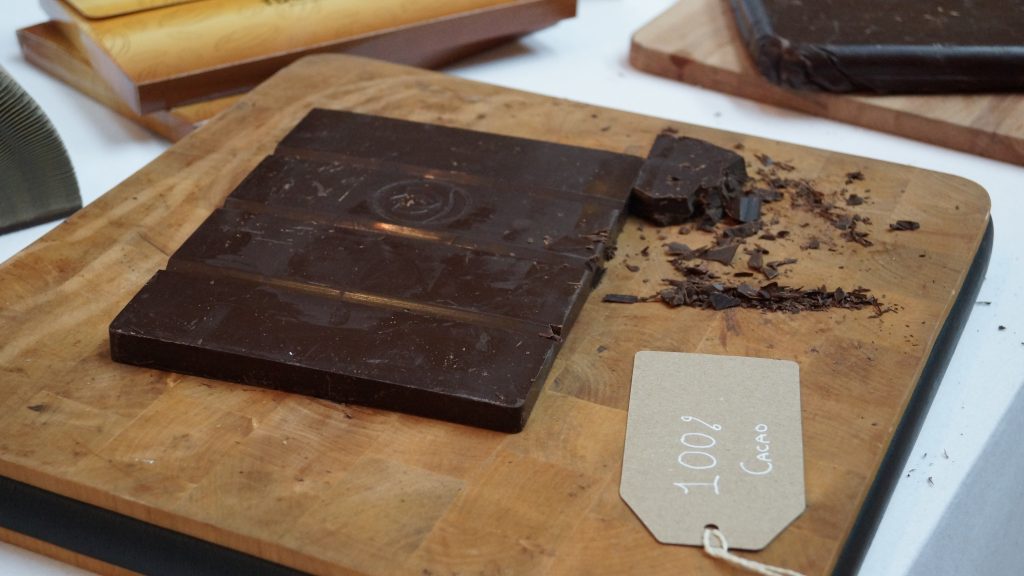
Rather than being biased towards or select a specific brand, we empower you with some facts via this blog post to choose the best dark chocolate in india by yourself! Chocolates in India are consumed to boost ones mood, rewards oneself or to boost energy levels. Most of these above needs are met by the consumption of milk chocolates. Over the last few years, consumers have become more concious, involved and discerning in their food and drink choices and favour healthy indulgences. Dark chocolate seems to fit that bill and is made out to be incredibly healthy and nutritious superfood. We look beyond the obvious in this thought piece and help you choose the best dark chocolate in India.
Medical Research done to support benefits of Dark Chocolate
with an aim to discover and create the Best dark chocolate in India, here are some links to the medical research that support the benefits of dark chocolate to human health:
https://pubmed.ncbi.nlm.nih.gov/16027246/
https://www.webmd.com/diet/health-benefits-dark-chocolate
https://health.clevelandclinic.org/dark-chocolate-health-benefits/
https://www.hsph.harvard.edu/nutritionsource/food-features/dark-chocolate/
https://www.njmonline.nl/getpdf.php?t=i&id=156#page=14
https://www.sciencedirect.com/science/article/abs/pii/S0261561420303575
https://academic.oup.com/jaoac/article/102/5/1388/5658268?login=false
https://www.mdpi.com/2072-6643/12/2/483
https://link.springer.com/article/10.1007/s11936-015-0419-5
https://www.sciencedirect.com/science/article/abs/pii/S1537189115001135
Market size of chocolates in India
The total estimated chocolate market size is expected to be Rs 17200 crore in 2019 and growing at 16% compounded annually. Real chocolates made with cocoa butter (and not hydrogenated vegetable oils) form a smaller part of the market. An even smaller but really fast growing sub-segment is the bean-to bar chocolate. The bean to bar chocolate market is estimated to be Rs 8 crore as of 2019. It is expected to grow at 200-250% annually over the next two-three years. Most of the bean to bar chocolate products are vegan and dark and hence relevant to this discussion.
History of Cocoa
Cocoa beans is the seed of the fruit of Theobroma Cacao tree. The use of cocoa beans has changed over the last 1000’s of years from when it was discovered. Maya and Aztecs drank it as a bitter spicy and fermented beverage during ceremonies and considered it healthy and spiritual. The drink was considered a source of wisdom and energy and also an aphrodisiac which had a soothing effect. Click to see video of how you can make a similar drink.
About 160 years ago, milk and sugar were added to cocoa. This created what we today know as chocolate. Milk, Sugar and Cocoa were ground together to form a smooth sweet paste and then moulded. Today, we consume cocoa in this delicious sweet form. To understand the process of chocolate making from farm to bar, please click video link here.
“With grapes, you can choose to make grape juice or fine wine. Cacao is no different.”
– L Nitin Chordia, India’s 1st Certified Chocolate & Cocoa Taster
Flavours of cocoa
Cocoa and hence chocolate flavour is an extremely complex mixture of more than 500 naturally occurring flavour compounds. When the cacao is fine and treated with care, the resulting chocolate offers an endless rainbow of flavour possibilities. The art of tasting fine chocolate or appreciating is much like Tea, Coffee, Wine, Whisk(e)y or Single Malt tasting. Chocolates made with Fine flavour cocoa beans can boast of Fruity, Floral, Herbal, Dairy, Toasted, Spicy, Earthy, Cocoa, Nutty and Caramel/Dark sweet flavour notes. These flavour notes are not ingredients added to the chocolate, but the inherent flavours that fine cacao carries as a mixed result of genetics, terroir, origin, weather and post-harvesting processes like Fermentation and Roasting. Each step of harvesting of Cocoa (Fermentation & Drying), Transportation, Storage and chocolate making (Roasting, Refining, Conching) and packaging has a potential impact on flavour and can be detected by tastings.
Facts about Cacao, Cocoa & Chocolate
The existence of several hundred aroma compounds in cocoa as seen above are scientifically proven. However, you should be surprised that, most of the scientific research done to back the health claims of dark chocolate are biased because they are industry funded. Every research aims at convincing consumers that dark chocolate is the super food they have been waiting for. Hence, we need to consider a few additional and important facts.
Health Benefits
Difference between Cacao & Cocoa
Chocolate is usually made by processing cocoa beans and adding ingredients. Cocoa beans are got from the cocoa fruit which is grown on the tree which is botanically called Theobroma cacao. The farmer harvests the fruit, ferments the cocoa beans and sun-dries it. Untill this stage, since no artificial process is carried out, the cocoa beans is referred to as Cacao. Products sold untill this stage are referred to as Cacao beans, Cacao nibs, cacao powder etc. Once it reaches the chocolate maker, roasting the cacao beans is usually the 1st process. Once the cacao beans are roasted (heat treated), the industry starts referring to them and all products made from them with the term Cocoa (Cocoa nibs, cocoa powder etc).
Dark chocolate do have some impressive proven health benefits as it is naturally high in Iron, Copper, Magnesium, Zinc, Phosphorus, Flavonoids (Antioxidants). However, the amount of chocolate one would have to consume to derive those benefits seem to shock most people! The most talked about ingredient is antioxidants.
Antioxidants in Chocolate
Oxidative stress or oxidation is an imbalance of free radicals and antioxidants in the body, which can lead to cell and tissue damage. Oxidative stress occurs naturally and plays a role in the aging process and causing various illness. Antioxidants are substances that help stop or limit damage caused by the free radicals. Cocoa beans contain approximately 6–8% polyphenols by dry weight which act as antioxidants which is more than is found in most foods.
Polyphenols can further be classified into 4 main groups namely Flavonoids, Phenolic acids, Polyphenolic amides and other polyphenols. Flavonoids are a diverse group of phytonutrients (plant chemicals) found in almost all fruits and vegetables. Flavonoids acting as antioxidants helps protects cells against damage from free-radicals and hence against diseases associated with oxidative stress such as heart disease and cancer.
It is safe to assume that most chocolate bars don’t deliver all the antioxidants because they can get destroyed during chocolate processing. The U.S. Department of Agriculture’s Database of Flavonoid Content provides us valuable data. In each gram of a typical 70% dark chocolate, there is about 1 milligram of flavonoid. In the case of milk chocolate there is only .15 milligram of Flavonoid Content in each gram of chocolate! Source
How much chocolate should one consume?
A person needs to get an average of 670mg of Flavonoids which can potentially help maintain stable blood pressure by maintaining blood vessel elasticity. One would need to consume about 600 gms of dark chocolates per day or about 2 and a half kgs of milk chocolate per day to get that amount of Flavonoids! Clearly you cannot be consuming that much chocolate! Hence regulate and limit your chocolate intake. Try and stick to chocolates that are 70%+ cocoa content to access a few flavonoids.
Composition of the Fat in chocolate
Cocoa butter consists of palmitic, stearic and oleic acids in equal parts. Palmitic acid, a solid, saturated fat, are linked to increases in LDL cholesterol and increases risk of cardiovascular disease. Stearic acid, which is also a solid, saturated fat, appears to have a neutral effect, which is surprising and uncommon among saturated fats. Oleic acid, meanwhile, a heart-healthy liquid monounsaturated fat also found in olive oil, decreases the risk of heart disease. It is believed that these effect of these 3 types of acids neutralises making cocoa butter a “not so bad” fat.
Amount of fat and sugar in dark chocolate
The nutritional profile of chocolate will depend on the different levels of cocoa butter and sugar added in chocolate. A 20g serving of 70% dark chocolate contains about 8g of fat, of which 5g is saturated fat, 6g sugar and 2g of fibre and protein. To compare, an 85% dark chocolate is higher in fat with almost 10g per 20g, of which 6g is saturated fat, but it is lower in sugar with just 3g per 20g. Hence it is important to keep an eye on the fat intake. Please remember that a 55% dark chocolate contains upto 45% sugar apart from added fat. A 50% dark cocoa chocolate should not even exist!
Calories in chocolate
A 70% dark chocolate is calorie rich and delivers about 520 calories per 100 Gms. A 80%, 100% or even a sugar free chocolate is not any lesser! The calories saved from sugars are compensated by the calories from cocoa butter. Milk chocolates have similar calories as dark chocolate. In short, a low calorie chocolate almost does not exist! For the calorie concious, this means balancing the amount of chocolate you should consume as part of your over all calorie intake per day.
Chocolates in baking
A chocolate cake is the most prepared and sold baked product in the cakes category. Only in a RAW chocolate cake can one expect to receive the benefits of the cocoa used. Baking involves high temperatures and additional ingredients which typically reduces the overall health quotient. However research suggests that Chocolate cakes made with baking powder resulted in complete retention of antioxidant activity and flavanol content, but with reduced cake heights and lighter cake color. Use of baking soda as a leavening agent was associated with losses of antioxidant activity and darkening color of cakes. Source
Caffeine in dark chocolate
Up to 400 milligrams (mg) of caffeine a day appears to be safe for most healthy adults. A shot (30 ml) of espresso contains about 63 Milligram of caffeine. 100 grams of 70% dark chocolate would supply about 80 Milligrams of Caffeine. 1 cup (225 gms) of green tea contains 25-29 mg of caffeine. However, some people are more sensitive to caffeine than are others.
Center filled chocolates
Popularly called as Bon Bons or Pralines, these chocolates that have delicious center fruit/nut/cream filling. The filling is usually fat/sugar based and is a calorie bomb! The chocolate is used only as a coating. At best indulgent, center filled chocolates have to be carefully avoided if the purpose of intake is improving ones health.
Is chocolate an aphrodisiac?
It is alluring to hypothesize that chocolate can have either a psychological or a biological positive impact on women’s sexuality. A study conducted in Italy found no significant differences between reported rates of sexual arousal when women were subjected to chocolates. BUSTED.
CocoaTRAIT of the best dark chocolate brands in India
Cacao Content of Best dark chocolate in India
Higher cocoa %, means higher amount of flavonoids (antioxidants) in the chocolate. Most non industry funded research suggests 70% cocoa content chocolate is the minimum recommended percentage for us to start looking to chocolate as healthy. A 50% or a 60% dark chocolate simply means there is way too little cocoa in your chocolate resulting in lesser flavonoids resulting in a lot of sugar.
Sugar Content of Best dark chocolate in India
100 minus the % of chocolate (For Eg: 100-70% = 30%) usually results in the amount of sugar in a dark chocolate. Reliable research warns that too much added sugar can be one of the greatest reasons for cardiovascular disease. There is no direct connection but several indirect connections. The American Heart Association suggests that men consume no more than 150 calories (about 9 teaspoons or 36 grams) of added sugar per day. A 70% Dark chocolate bar of 45 Grams each contains 13.5 Grams of sugar. In our previous research, we found that an average Indian sweet only has 36% sugar whereas a 50% dark chocolate has 50% sugar and a 60% dark chocolate has 40% sugar!
Type of Sugar
A lot has been said about the type of sugar to be consumed. Sugar derived from cane is most popular with chocolate makers in India. There are many studies about how cane sugar is all about “Empty Calories” without much nutrition. The difference between Refined and Unrefined (Muscavado / Khandsari) cane sugar are also too little to be concerned about. Except that unrefined sugar undergoes one less process A.k.a refining using sulphur. Alternate sweeteners like Coconut Sugar, Palm Jaggery, Stevia etc have certain other benefits like Lower Glycemic index and being locally produced. However, we must remember that any added sugar must be carefully examined and the calorie value should be considered. Sugar free chocolate does not even warrant a discussion since most of them are chemical based sweeteners.
Type of Fat
In the Indian context, it is important to note that not every dark chocolate is a dark chocolate! Many so called dark chocolates contain cheaper Hydrogenated Vegetable oil (Palm/Dalda/Vanaspathi) in addition to being sugar treats! These are called compound chocolates (A.k.a Fake chocolates in the west). You will find a lot of this in tourist places like Kodaikanal, Ooty and Munnar. Trans fat is the reason why Hydrogenated Vegetable oil is considered as a non essential ingredient in chocolate. Cocoa contains 50% naturally occurring cocoa butter. A chocolate is considered pure if it contains cocoa butter as the only source of fat. This could be added or naturally occurring cocoa butter.
Use of Dairy
Chocolate in the moulded bar form got popular when processed milk powder along with sugar was added to it. This was in 1875. The milk in chocolates makes the delicious creamy Swiss confections popular across the world. Today, a milk chocolate is synonyms with chocolates and a sweet treat. Several mass produced and economical chocolate brands also use Butter fat (Ghee) to add creaminess to the chocolate, soft texture and to extend the shelf life by resisting bloom. In addition to this, a new indulgence category called Dark Milk chocolates have started to get a lot of attention. Studies have observed that addition of milk or milk products reduces the Antioxidant Capacity of cocoa products by about 30%. The addition of dairy in chocolate interferes/reduces the body’s ability to absorb the nutrients of cacao. Popular 50% Dark chocolates have milk in them! Read the back of pack carefully.
Use of Emulsifiers/Preservatives
Emulsifiers and preservatives are used in chocolate to help to increase viscosity (make it thinner) to aid easier processing of chocolate in the production line. They also extend the shelf life of chocolate and help in storage by preventing bloom. The most commonly used emulsifiers in chocolate in india are Soy or Sunflower Lecithin (E322) an ingredient widely used by industrial chocolate manufacturers and which are plant based. Polyglycerol Polyricinoleate – PGPR, (E476) and Glycerol or Glycerine (E422) are also widely used chemical based emulsifiers in India. With Soy Allergies becoming a concern these days, the addition of Soy Lecithin need to be noted.
Use of Organic Ingredients
In the world we live in today, It considered hygiene and baseline by consumers to use organic ingredients while making chocolate (whether or not you claim it on the pack). The fact is organic beans do not guarantee fine flavour. Various factors like Fermentation, Drying and Roasting determine the flavour of chocolate. Hence, using organic ingredients does not always translate to “good for you” chocolate. The term organic on the pack makes it easy to add to the illusion of a chocolate being perceived as healthy. With high sugar and fat content used, an organic chocolate can also be a replacement to a candy!!
Use of Vanilla/Vanillin
Fine flavour cocoa beans cost a lot more than commercial cocoa beans. Industrial chocolates tend to use Pure Vanilla, Nature Identical Vanilla or artificial Vanillin to mask the off flavours in chocolate and use cheaper cocoa beans. To enjoy the pure taste of chocolate, one must choose a chocolate that has no vanilla or vanillin added.
Artificial Flavours or Essence
The lesser stressed in this the better. It is easy to find chocolate brands add artificial essences, flavours and nature identical flavours to their chocolate bars making it appealing. The popular flavours like Orange and Mint are the ones to look out for! The flavours are usually extracted using an alcohol process and are chemical based. This is a big one to watch out for!
Number of Ingredients
“Less is More”. This aptly applies to chocolate. If you are reading 6+ ingredients on your chocolate ingredient list, there is enough reason to be worried. 3 ingredients in a plain dark chocolate and 4-5 ingredients in a flavour variant is the norm.
Alkalisation or Dutch Process
Cocoa beans are acidic in nature. Industrial chocolate makers reduce the acidity, improve the flavour (make it more chocolatey) and appearance greatly (make it darker) by means of a chemical process called alkalisation. Alkalisation of cocoa results in darker colour and higher chocolate flavour. Evidence from the literature indicates that natural (non alkalised) cocoas are high in flavonoids, but when the cocoa is processed with alkali, also known as Dutch processing or Dutching, the flavonoids are substantially reduced. Your search for best dark chocolate brand in India just got narrower!
Processing Temperature
Cocoa is usually roasted to unlock flavour precursors that have developed during fermentation of cocoa. Fermentation causes temperatures to rise to 55°C. Roasting happens anywhere between 100-160 Degrees Celsius. Chocolatiers roast to bring out the best flavour. Some research points to roasting at lower temperatures (110°C) helps in preserving the bioactivity of roasted cocoa beans. Processing it as raw chocolate helps keeping the live enzymes intact and staying abundant in minerals like zinc, magnesium & calcium.
Most chocolate makers prefer to roast cocoa as an assurance that they would be killing any unnecessary bacteria or pathogens that might exist in cocoa. According to the National Confectioners Association (based in the U.S.), raw/un-roasted cacao beans are susceptible to bacteria & other forms of contamination; the heating/roasting process is actually what destroys that bacteria.
Single Origin Dark Chocolate
A single origin chocolate bar indicates that all the cocoa beans used in the process of making the chocolate originates from the same country. Origin of the beans do have an influence on the flavour profile of the chocolate to an extent. This gets complex because cocoa from the same country can have multiple varietals, Hybrids and Terroir. However, this allows a chocolate maker to offer variations of chocolate with differing flavour profiles. There are indications that beans from some origins have more antioxidant capabilities than others. However, the Genetic Varietal, Terroir and Post harvest processing at the farm do contribute to the differences.
Awards Won
Most artisanal chocolate bars win awards in several small or big competitions held across the world. It is thus important to note of the awards are specific to chocolate or have a reputation to go by. Winning an award for chocolates organised by a food body in another country might not necessarily mean much. Please do note the reputation of such awards.
Marketing Labels
Marketing terms such as Artisanal, Hand made, Hand Processed should make you defensive. Artisanal is defined as: Any product made in a traditional way by someone who is skilled with their hands. There is absolutely no chance of bean to bar chocolates being made by hand! It is a highly mechanised process and any claims to this effect should be questioned with disbelief. If a product reads organic or fairtrade certified, it is important to verify the authenticity of the claim.
So, which is the Best dark chocolate brand in India?
It might now be clear that you have to WTF – Weigh The Flavonoids before you decide the Best dark chocolate brand in India and consume chocolate to derive health benefits from it. On the face of it, it seems that it is best to go back in time and drink chocolate like the Maya and Aztecs did rather than eat it! In your quest to derive health benefits from the Best dark chocolate brand in India, we recommend that you:
- Consume cacao as much as possible in its minimally processed form. You could add Cocoa Nibs in Vegan Smoothies, Pan Cakes, add as toppings on Fruit Salad/Salads/breakfast cereals/brownies/pastries, spreads and condiments like a Cocoa Nib Hummus/Pesto etc
- Attempt to drink more than eat cocoa. Make interesting Vegan beverages from cocoa to avoid the fat as much as possible and get the best out of cocoa!. A Traditional Vegan Mexican Style Hot chocolate or Ceremonial Cacao is your best bet!
- Consume 70% cocoa or more Vegan Non Alkalised Bean to Bar Dark Chocolate in moderation (say 15-20 gms 4-5 times a week).
- Pair Vegan dark chocolate with other flavonoid rich beverages and fruits like red wine, tea, coffee, circus fruits and apples. A sip of warm green tea followed by a bite of dark chocolate can be an immersive flavour experience.
- Combine cacao or Vegan dark chocolate innovatively with other (non flavonoid) antioxidant rich fruits, vegetables, nuts wholegrain and meats listed in this link.
You can evaluate the consumption of dark chocolate (above 73%+) to boost your mood, reward yourself, boost energy levels, for its various health benefits or for no reason at all. However, like for everything in life, moderation is the key. Low cocoa % chocolate usually means more sugar. Chocolate with any milk products in its ingredients should be treated as pure entertainment or enjoyment with no associated health benefits. Please take a look at the ingredient list clearly. Best of luck while choosing the best dark chocolate in India!
– L Nitin Chordia, India’s 1st Certified Chocolate Taster
About the Author of Best dark chocolate brand in India: L Nitin Chordia is a Sparing Partner and a Business Consultant with over 15 years of experience in Indian FMCG and Retail Domain. Nitin has worked with large brands and FMCG companies both in india and overseas with growing focus in Vegan Bean to Bar chocolate. Nitin is India’s 1st Certified Chocolate Taster, Cocoa post harvest professional and Judge at the International Chocolate Awards, London. Cocoatrait is an initiative to promote knowledge, production and consumption of fine chocolates in India. Nitin is the 1st external faculty at the Institute of fine chocolate tasting, UK. Cocoatrait operates the only one of its kind virtual chocolate tasting club in India with an aim to connect Chocolate Lovers with Chocolatiers. Nitin along with his wife Poonam (a trained chocolatier) has initiated Cocoashala, a chocolate school which helps you discover Bean to Bar chocolate making and beyond. Nitin also offers Cocoashala as an CIAAS (Chocolate Infrastructure As A Service) facility. We also operate the world’s 1st Zero Waste, Sustainable and Eco Friendly Bean to Bar chocolate contributing to the Circular Economy called Kocoatrait.















